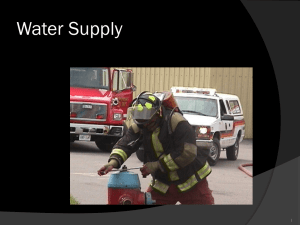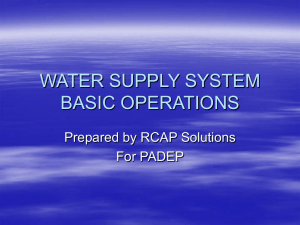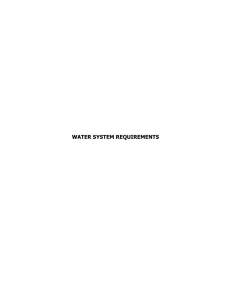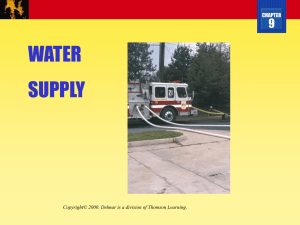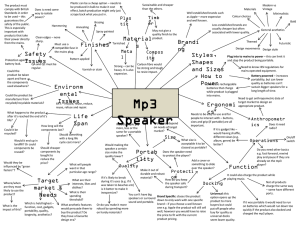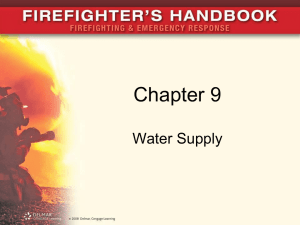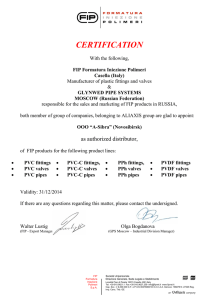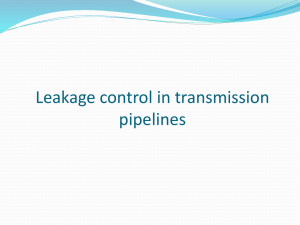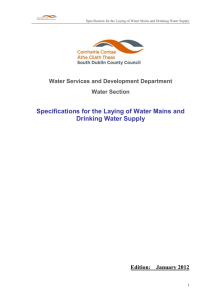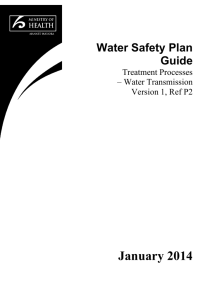Monitoring and Assessing Water Quality
advertisement
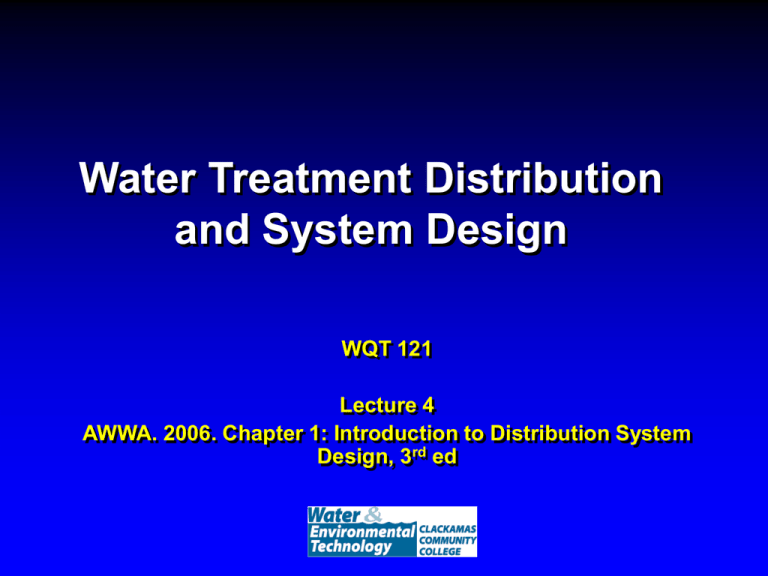
Water Treatment Distribution and System Design WQT 121 Lecture 4 AWWA. 2006. Chapter 1: Introduction to Distribution System Design, 3rd ed Week Objectives Reading assignment: Handouts: Transmission and Distribution Pipelines AWWA. 2006. Ch1 Water Transmission and Distribution 1. Understand Operators Role in Distribution 2. Understand types of water systems and water system planning. 3. Understand main sizing, pressure, velocity, and piping materials Water distribution systems consists of pipes, storage facilities, pumping station, valves, fire hydrants, meters and other appurtenances? 1. True 2. False ls e 0% Fa Tr ue 0% Key Words • Surface Water Systems: Treatment and use of surface water to supply industries and domestic residences. • Groundwater Systems: Groundwater extracted for the sole purpose of supply. • Purchased Water Systems: A water utility that purchases water from another entity (may be contaminated or cant meet demand). • Rural Water Systems: Located in rural areas and may be many miles away from customers. They can use surface or groundwater for supply. Key Words • Dead ends Single main that is difficult to repair and maintain proper flow (should be avoided in water supply) • Shut Off Valves Necessary for easy access to repair and maintain a water system. • Main Sizes – Must be sized to meet the peak domestic, commercial, and industrial demands in the area to be served. • Water Distribution System – made up of pipes, valves, and pumps which treated water is moved from treatment plant to consumers. A system includes water treatment facilities, water meters, water storage and fire protection. *** Want sufficient volume at adequate pressure.*** Operators Role in Distribution 1. Operate system to maintain water quality, positive pressures, and control water velocity and direction 2. Maintain pipes, valves, pumps, to ensure flow 3. Operate system to accommodate demand 4. Install connection to new users 5. Maintain main line and customer water meters. Operators Role in Distribution 6. Read meters 7. Sample and maintain water quality 8. Operate a cross connection control program 9. Maintain maps and records 10.Keep up to date on new technologies 11.Recommend repairs, replacements, or improvements. 12. Provide good safe clean drinking water The average amount of water used per person per day is: a. 25-30 gpd b. 50-60 gpd c. 75-100 gpd d. 100-150 gpd gp d 0 gp 10 d. c. 75 -1 0 015 0 -6 0 50 b. 0% d 0% gp d gp -3 0 25 a. 0% d 0% The utility’s annual average day demand is determined by dividing the? 0% se da y ... p. .. 0% d. A ve ra ge er u W at ta l To b. c. se er u W at 0% w at er ... p. .. 0% a. a. Water use per month by the number of days in that month b. Total water use for a year by 365 days c. Water use per week by seven days d. Average day demand by the number of residents Public relations are important because we: 1. Want to finish our work in a hurry 2. Don't want to be late for lunch 3. Hate listening to whiners 4. Must deal with the public 5. Want to keep our jobs ob s ... rj ep ke to an t W ou th e w lw ith to M us td ea ng en i lis t pu hi .. . f.. te la be to H at e an t 't w on D W an t to fin is h ou rw o. . 0% 0% 0% 0% 0% The primary role of a water operator is? Avoid boil orders Test the water Treat the water Provide safe clean water that is free of bacteria and toxic chemicals w a. .. at er n w Pr ov id e sa f e cl ea tt he Tr ea th e st Te vo id bo il o w rd e at e rs r 0% 0% 0% 0% A 1. 2. 3. 4. Operators of water distribution systems are responsible for? 1. Safe drinking water to everyone 2. Keeping prepared for the future 3. Operating and maintaining systems 4. All of the above ov e . ft he ab nt .. m ai A ll o d an ra tin g pe O pi ng ee K Sa fe dr in pr ep ki ng w ar e d at e rt ... fo r.. . 0% 0% 0% 0% Successful communication requires mutual: Agreement Confusion Transmission Understanding 0% ng U nd er s sm is ta nd i si o n Tr an C on fu si o m en gr ee 0% n 0% t 0% A 1. 2. 3. 4. proposed solution and offer to conduct a tour of the plant for those complaining 2. Keep all persons except for operating personnel out 3. Never admit there is a problem or cause for the complaint 4. Publicize the problem as much as possible pr ob le . .. ... Pu bl ic iz e m it ad er ev th e th er e is ex ce ns er so p ee K Ex pl ai n al lp th e pr ob le m ... .. 0% 0% 0% 0% N 1. The best approach to complaints involving the operation of a water plant is to: Explain the problem and If a water supply exceeds the MCL, whose responsibility is it to notify the consumer? the testing lab. the supplier. the DOH the USEPA 0% e e US E DO PA H 0% th e th th su pp lie la b tin g te s e 0% r. . 0% th 1. 2. 3. 4. Surface Water Systems • Surface water sources are open to contamination from human and animal waste and other pollution. •Must comply with the federal Surface Water Treatment Rule (SWTR) and include filtration, disinfection, operating, monitoring, and reporting requirements. •Water is always treated prior to distribution •Treatment for Microorganisms, turbidity, and must have a minimum disinfectant residual. Case Study: Willamette River Water Treatment Plant Wilsonville, OR •Intake Screens in Willamette River Case Study: Willamette River Water Treatment Plant Wilsonville, OR • Opened April 2002 •Can process 15 million gallons per day (mgd). •Low of approximately 2 mgd in the winter to nearly 6 mgd in the peak of the summer. •City's water system includes storage tanks throughout town with a total combined capacity of nearly 11 million gallons. •Wilsonville's former water supply (a system of 8 local wells) is also available for use in emergencies. Case Study: Willamette River Water Treatment Plant Wilsonville, OR Enhanced Sedimentation Phase coagulants and fine sand Clarified water Case Study: Willamette River Water Treatment Plant Wilsonville, OR Ozonation Liquid Oxygen Converts O2 gas to O3 (ozone) Case Study: Willamette River Water Treatment Plant Wilsonville, OR Granular Activated Carbon 6 feet of charcoal w/1ft sand remove residual turbidity, pathogens, organic chemicals, and taste/odor compounds Case Study: Willamette River Water Treatment Plant Wilsonville, OR Chlorine Disinfection maintain disinfection as the water is pumped through pipes to customers at the far ends of the City's water distribution system. Groundwater Systems • Groundwater extracted for the sole purpose of supply. •May not require treatment • Space wells so don’t need large transmission pipes Purchased Water Systems • Groundwater or surface water supply becomes inadequate (West Linn & Lake Oswego) • Contamination • Operator may not need to treat • Good quality water • Must be good accountants Rural Water Systems • Supplies water to remote regions • Can be groundwater or surface water supply • Fire protection can be limited Water System Planning Issues • Water availability • Source reliability • Water quality • Location • State and Federal requirements The size of water mains, pumping stations, and storage tanks is primarily determined by? 67% 1. Maximum day demand during any 24 hour period during the previous year 2. Population served 3. Per-capita water use 4. Fire protection requirements 33% . pr ot ec w Fi re ita rca p Pe tio n pu la Po tio at .. r.. . se de . da y im um ax M ... 0% .. 0% Why is excessive water pressure to residential homes objectionable? 14% 14% m in g ... ... th e n. .. fo a s se C au se s re a ec D se s au C cr ea se s er os io pa rt .. . 7% In 1. Increases particulate matter reaching customer 2. Causes erosion of copper plumbing due to the high velocities, giving the water a metallic taste 3. Decreases the life of water heaters and other water bearing appliances 4. Causes foaming of faucets 64% Policy Considerations • Current and future growth • Costs • Financing Methods • Zoning and Ordinances • Regulatory Issues Which of the following are important for system layout A. planning the system, B. configuring a system, C. mapping a system, D. choosing a valve arrangement E. All of the above 96% D e ab ov ... ve he ft ll o A E. in g ho os .c pi ng a a va l sy st em , , st em sy a C .m ap ur in g on fig .c B A .p la n ni n g th e sy st em , 0% 0% 0% 4% What are some of the programs and operational procedures that can be implemented by water utilities to help ensure the delivery of the best water quality to the consumers? 100% of .A ll D .M on C th e w at ito r th e h lu s .F B ... .. s. a. h bl is st a .E A 0% ... 0% .. A. Establish a cross connection control program and maintain system pressure over 30 PSI, B. Flush the system periodically and maintain the highest possible disinfectant residual at all times C. Monitor water quality throughout the distribution system, and take actions when 0% observing signs of water quality deterioration D. All of the above System Layout • Plan and Configure •Arterial-large mains surround system •Grid-All mains interconnected, water from several locations •Tree-water starts with transmission main and branches off • Map and Size Which of the following is a distribution layout pattern? Dendritic Grid Parallel Brush 100% ru s h 0% B le l ra l G rid 0% Pa en dr iti c 0% D 1. 2. 3. 4. Complaints of poor water quality will most likely occur in which type of main layout? 100% Arterial Loop Tree Grid Nebular 0% eb ul a r rid G Tr ee 0% N rt er ia lL oo p 0% A 1. 2. 3. 4. An arterial-loop distribution system has flow from how many directions? 1 2 3 4 67% 17% 11% 4 3 2 6% 1 1. 2. 3. 4. Dead Ends • Dead End Mains • Restricted flow because of one main • Water can become stagnant or degrade • All customers beyond repair point lose water access when main is fixed. (a) In order to provide increased reliability of service and reduce head loss, dead ends shall be minimized by making appropriate tie-ins whenever practical. (b) Where dead-end mains occur, they shall be provided with a fire hydrant if flow and pressure are sufficient, or with an approved flushing hydrant or blow-off for flushing purposes. Flushing devices shall be sized to provide flows which will give a velocity of at least 2.5 fps in the water main being flushed. No flushing device shall be directly connected to any sewer. What water quality problem is most likely to occur at dead-end mains? 1. Dirty water 2. Taste and odor 3. Milky water due to air bubbles 4. Dirty clothes due to manganese 78% 22% ... 0% ... ot he s cl ir t y y ilk M st e Ta D w at er od an d w ir t y D du or at er 0% Mapping • Existing System • Existing and planned streets • Expansion areas • All topographic and subsurface features • Population densities and predictions • Normal water consumptions • Proposed additions or changes Valving • Need shutoff valves (repair and maintenance) •Valves shall be located at not more than 500 foot intervals in commercial districts and at not more than one block or 800 foot intervals in other districts. Where systems serve widely scattered customers and where future development is not expected, the valve spacing shall not exceed one mile. • Air and vacuum at high points • The air relief valve should be placed so as to prevent problems due to freezing. A shutoff valve should be provided to permit servicing of any air relief valve. • Blowoff valves at low points • Backflow prevention devices The sudden closure of a check valve will result in water hammer flow reversal cavitation water aeration 81% 14% ... 0% ae ra tio n ta tio n vi w at er ca re v w flo at er ha m er sa m er l 5% w 1. 2. 3. 4. Mains • Must supply for fire flow requirements (Fire insurance code) and domestic use • High value districts (8-12”), Residential (6-8”) Sized to meet peak demands For water mains not connected to fire hydrants, the minimum line size shall be 4-inch diameter. Minimum water main size serving a fire hydrant lateral shall be 8-inch diameter unless a hydraulic analysis indicates that required flow and pressures can be maintained by smaller lines. Guidance: Generally, velocity in a water main should not exceed 5 fps. Mains should be designed with sufficient excess capacity to provide for anticipated future connections. Pipes of dissimilar metal should not be connected together because of problems due to 100% 1. scale formation 2. corrosion 3. water hammer 4. the venturi effect tu ri. . e. .. 4. at er w th e ha ve n m m io n rr os co 2. 0% . 0% 3. 1. sc al e fo rm a. .. 0% Fire Hydrants The design of the distribution system shall be consistent with Appendix B of the 2003 International Fire Code. As specified in this code, minimum fire-flow requirements are: 1. 1000 gpm for one- and two-family dwellings with an area of less than 3600 square feet. 2. 1500 gpm or greater for all other buildings. 3. Average spacing between hydrants must be no greater than 500 ft. Guidance: Generally, individual hydrant spacing may range from 350 to 500 feet depending on the area being served. Hydrants should be provided at each street intersection and at intermediate points between intersection. The planning of hydrant locations should be a cooperative effort between the water utility and local fire officials. 4. Exceptions can be granted 5. Water mains not designed to carry fire flows shall not have fire hydrants connected to them. 6. The design engineer shall verify that the pipe network design permits fire-flows to be met at representative locations while minimum pressures as required by R309-105-9 are maintained at all times and at all points in the distribution system. Guidance: For guidance on conducting this analysis, refer to AWWA Manual M31, Distribution System Requirements for Fire Protection. 7. As a minimum, the flows to be assumed during a fire-flow analysis shall be the "peak day demand" plus the fire flow requirement. When using a fire hydrant, the valve: 1. should never be opened completely 2. be opened only during the hours of 8 AM to 5 PM 3. be opened to the desired amount of flow 4. be opened all of the way 70% 20% .. . a. t.. en ed op be 4. be 3. op be 2. op en ed en ed o. ... rb ve ne ld ou sh 5% .. 5% The primary reason for dry barrel fire hydrants is to: 1. allow easy maintenance 2. prevent water hammer 3. keep the hydrant from freezing 4. keep the barrel from rusting 83% 17% re ... .. ba r ra . th e ep ep ke ke th e hy d tw at er pr ev en sy ea lo w al 0% ... m ai ... 0% Main Pressure •Minimum static pressure 35 psi (High fire flow) • During use not drop below 20 psi •Residential water pressure 50-75 psi • The distribution system shall be designed to maintain minimum pressures as required in R309-105-9 (at ground level) at all points of connection, under all conditions of flow, but especially during peak day flow conditions, including fire flows. •Guidance: The normal working pressure in the distribution system should be between 40 and 60 psi. When static pressure exceed 80 psi, pressure reducing devices should be provided on mains in the distribution system, or individual home pressure reducing valves should be installed per the Utah Plumbing Code. Which of the following does not affect the friction loss in a given length of pipe? 58% 1. hardness of the water 2. number of fittings 3. roughness of the interior of the pipe 4. velocity of the flow 21% 21% of ... o. .. 4. ve lo c ity ss gh ne 3. ro u m be nu 2. 1. ha rd n es s ro of .. . ff ... 0% From a sanitary standpoint, the pressure in a distribution system should never be allowed to fall to zero because 1. low pressure allows bacteria to multiply 2. ground water may enter and back siphonage may occur 3. the chlorine residual will drop faster 4. the main may collapse 76% 18% 0% m ai n m a. .. ... or in 4. th e ch l th e 3. nd gr ou 2. 1. lo w pr es su w at e. .. r.. . 6% Main Velocity and Materials • Minimum 5 ft/sec • What are a materials strength, pressure rating, durability, corrosion resistance, smoothness of inner surface, ease of tapping and repair, maintenance? •External load- pressure on pipe from ground after burial •Internal load -hydrostatic pressure of water within pipe • Pipes should be rated at 2.5-4 times pressure rating of system) •PVC, Iron, Steel, Concrete Polyethylene pipe material will reduce water loss, is economical, and is capable of handling a variety of environmental conditions from extreme cold, earthquakes and corrosive materials. 1. True 2. False 92% ls e Fa Tr ue 8% A positive pressure in the distribution system is desirable to keep toxic substances out of the system. 100% Fa ls e 0% Tr ue 1. True 2. False In general, if a water utility produces 40 to 60 pounds per square inch (psi) of water in its water mains, individual service pressure should be sufficient to provide adequate pressure when measured on the customer's side of the meter. 96% Fa ls e 4% Tr ue 1. True 2. False The size of the water treatment plant as well as the number of specific processes it uses depend on which of the following 100% ov e ab ft he rit y A ll o pu ua rq at e W ... er w at lit y in s rit ie Im pu d ra w w at er fo r si de on em an D tc os b. .. ra tio ns 0% 0% 0% 0% C factors? a. Cost considerations b. Demand for water by population served and Fire protection needs c. Impurities in raw water d. Water quality purity standards e. All of the above Two fundamental treatment requirements for public water systems using surface water sources are: 1. Coagulation and sedimentation 2. Lime softening and disinfection 3. Filtration and aeration 4. Disinfection and filtration 95% ra ... an d D is i nf ec tio n an tio n ltr a Fi d ae d an in g fte n so m e Li fil t di ... d. .. se d an n at io gu l oa C ra tio n 5% 0% 0% The objectives for this week to become familiar with basic operator duties and distribution system layouts has been met 43% 38% Strongly Agree Agree Neutral Disagree Strongly Disagree 10% .. Di s ly is a St ro ng D 5% ag . gr ee tra l eu gr ee A N ly Ag re e 5% St ro ng 1. 2. 3. 4. 5.
